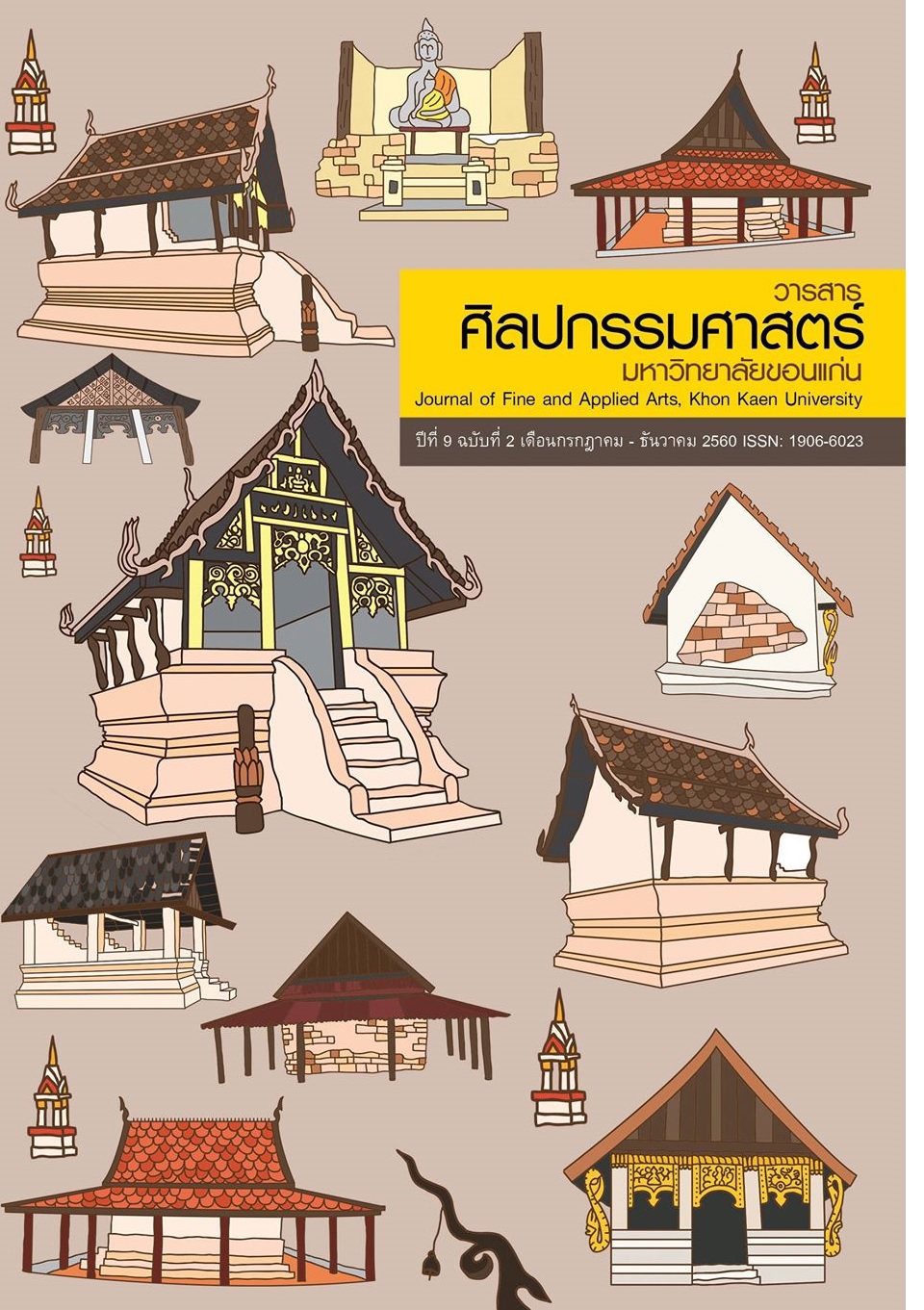การสร้างสรรค์สีเป็นมิตรกับสิ่งแวดล้อมประยุกต์สู่การออกแบบ Creative Environmental Friendly Coloration System for Design
Main Article Content
Abstract
การวิจัยครั้งนี้วัตถุประสงค์เพื่อศึกษาภูมิปัญญาทางด้านสีไทย วิเคราะห์ลักษณะสีที่เกิดจากวัสดุที่เป็นมิตรต่อสิ่งแวดล้อมโดยอาศัยภูมิปัญญาด้านสี วิเคราะห์และทดลองหาอัตราส่วนของสีจากวัสดุจากธรรมชาติ วิเคราะห์ลักษณะทางกายภาพของสีเกิดจากการหาอัตราส่วน จัดกลุ่มระบบสีที่เกิดจากวัสดุจากธรรมชาติเป็นหมวดหมู่ และสังเคราะห์ภูมิปัญญาทางด้านสีที่เกิดจากการวิเคราะห์โดยนำผลการวิจัยไปประยุกต์ใช้ในงานผลิตภัณฑ์และงานกราฟิก โดยสร้างต้นแบบผลิตภัณฑ์เพื่อเป็นแนวทางในการพัฒนาเชิงพาณิชย์และสร้างหนังสือการนำองค์ความรู้ทางด้านสีไปใช้เป็นแนวทางด้านสีและการสร้างสรรค์ผลิตภัณฑ์และงานกราฟิก โดยใช้แบบแผนการวิจัยผสมผสานวิธี โดยใช้กลุ่มวัสดุที่ศึกษาแบ่งออกเป็น 8 ชนิด คือ ฝาง กระเจี๊ยบ ครั่ง ขมิ้น แก่นขนุน หูกวาง เพกา และอัญชัน โดยใช้สารที่ทำให้เกิดสีที่ได้จากภูมิปัญญาชาวบ้าน 5 ชนิด คือ ขี้เถ้าไม้มะขาม ปูนเปลือกหอยแครงเผา เกลือแกง สารส้มและมะนาว โดยนำทดลองตามวิธีจากทฤษฎีเส้นตรง และจากทฤษฎีสามเหลี่ยมด้านเท่าและนำสีที่ได้มาวิเคราะห์ และจัดหมวดหมู่สี ร่วมกับรูปแบบสีไทยและสีสากลและสร้างชุดชื่อสี และนำองค์ความรู้จากภูมิปัญญาการสร้างสรรค์สีที่เป็นมิตรต่อสิ่งแวดล้อมประยุกต์สู่การออกแบบโดยมีแบบประเมินความคิดเห็นองค์ความรู้ที่ได้จากการทดลองประยุกต์การสร้างสรรค์งานผลิตภัณฑ์และการสร้างสรรค์งานกราฟิก
ผลการวิจัยปรากฏว่า สีที่เกิดจากการสร้างสรรค์จากวัสดุธรรมชาติในท้องถิ่นเป็นการส่งเสริมเอกลักษณ์และสามารถลดผลกระทบต่อสิ่งแวดล้อมอย่างมีประสิทธิภาพโดยการนำวัสดุธรรมชาติใกล้ตัวในท้องถิ่นที่อยู่ใกล้ตัวมาดัดแปลงสร้างสรรค์ให้เกิดประโยชน์ ซึ่งสีที่เกิดจากวัสดุมีโทนสีเรียงตัวกันตามสารที่ทำให้เกิดสีที่ได้จากภูมิปัญญาชาวบ้านที่มีค่าความเป็นกรด-ด่าง (pH 1-14) โดยมีเอกลักษณ์เฉพาะของสีที่เกิดจากแผ่นดินแม่หรือแผ่นดินที่ให้กำเนิดวัสดุและภูมิปัญญาในท้องถิ่น ซึ่งแบบรูปแบบใหม่ที่สร้างความแตกต่างในรูปแบบอัตลักษณ์ของไทยสีในท้องถิ่น การนำองค์ความรู้จากการศึกษาไปใช้งานโดยสร้างเป็นหนังสือสามารถนำความรู้ไปใช้เป็นประโยชน์โดยแบ่งการประเมินความคิดเห็นที่มีต่อองค์ความรู้ทางด้านวัสดุและกรรมวิธีการผลิตสี มีเหมาะสมมากที่สุด
The purposes of this research were: 1) to study Thai color wisdom by analyzing color characteristics of environmentally friendly materials based on the color knowledge, 2) to analyze and experiment the color ratio from the natural material, 3) to analyze the physical characteristics of colors by finding the ratio, grouping of color systems derived from natural materials into categories, and synthesizing the color knowledge derived from analysis by applying research results into products and graphics. Creating product prototypes was to guide commercial development and creating books. Bringing the color knowledge was to use for color processes and create products and graphics by using the mixed methodology. The study materials were divided into 2 types: sappan, jackfruit, by using 5 colors of folk wisdom: ashes, mortar shell, salt, alum and lime. Experiment based on the linear and equilateral triangle theory has been using with the color for the analysis, and classified colors in combination with Thai color and universal color scheme. Creating a set of color names and bring the knowledge to create environmentally friendly colors was to apply with the design with the evaluation form, and the knowledge acquired from experiment to apply for product and to create graphic design.
The results of this research were as follows. The colors derived from the creation of local natural materials are to promote identity and to reduce the impact on the environment effectively by bringing local natural materials to adapt and create benefits. The color from the material was tinted according to the color of the folk wisdom that has a different pH value (pH 1-14). These unique colors of the mother’s land or land gave birth to local materials and wisdom. This new style made a difference in the identity of Thai local color. The use of knowledge from the study to create a book could be useful to share by evaluating to the knowledge for the material and the process of producing color that were the most.
Article Details
Content and information in articles published in the Journal of Fine and Applied Arts of Khon Kaen University is regarded as the opinion and sole responsibility of the author(s) directly; therefore, editors are not obliged to agree to or share any responsibility with regard to the content and information that appears within these articles.
All articles, information, content, image, etc. that have been published in the Journal of Fine and Applied Arts of Khon Kaen University is the copyright of the Journal of Fine and Appllied Arts of Khon Kaen University. Any person or organization who wishes to distribute all or parts of the articles for further dissemination or other usage must first receive permission from the Journal of Fine and Applied Arts of Khon Kaen University before proceeding to do so.

